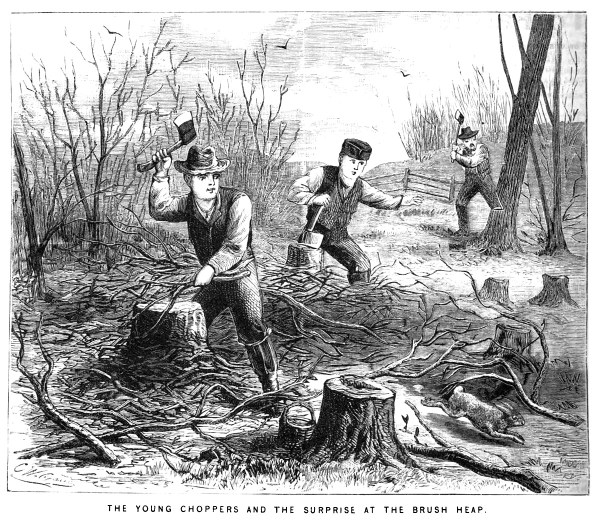
It is an old saying that a child must creep before it can walk. We grow by degrees in almost every thing, and in nearly every direction. The child gradually increases in size—though not so very gradually sometimes—until it comes to the stature of a man or woman.
We grow in knowledge—at first knowing but little, the child slowly acquires the information that, if rightly used, will make him wise in mature years. So it is everywhere, “little by little” the great gains are made. It is step after step that the highest mountain is climbed; one brick upon another and the greatest wall is laid. “Little drops of water; little grains, etc.”
Thoughts like these come to me as I glance back to my boyhood days, and review in memory the actions and the hopes of the child. Like most farmer’s boys I had a liking for the axe, and was always glad to go to the forest, and help make the firewood for the year. It was my ambition to swing the sharpest axe at the foot of the largest tree, and with my own hands bring the giant of the forest, a subdued monarch, crashing to my feet.
All boys feel more or less this inborn spirit or longing for doing great things, and it only needs the proper training to transform the ambitious youth into the strong and useful man. It is not the most natural thing for a boy to content himself with the cutting of the brush, when he sees the more manly work of felling trees going on before him.
I know just how the boy feels, because I was once a boy; and it is not difficult for me to realize the state of mind the boy is in who cuts the “small wood,” while the great sticks of timber are being worked out of the body of the tree by the skilled workmen with the saw and axe.
But the young woodsman must “creep before he can walk,” in the use of his edged tool, and when he is set to the work of “cleaning up the brush,” he is having that done for him that is by all means the best. This is a kind of chopping at which the lad can make some considerable headway.
The fruits of his labors are easily seen in a pile of fire wood, while if he had attempted to cut a large log in two, he would only have made an ugly looking gash in the log—perhaps also one in his foot!—and a quantity of scattered chips, each one of which would have told a Chopper that the young wood cutter was not equal to his work.
“A workman is known by his chips.” The cutting of the brush-wood is boy’s work, and is just the kind that not only should give an opportunity to train his hands and arms for harder chopping, but also keep him from getting at all discouraged. He can here do a finished work, and have a pile of valuable wood to show for his efforts.
This is the “creeping,” which, if rightly done, both as to the swing of the little axe, and the spirit in which the work is entered into, that will enable the young chopper to “walk” with a firm and confident step, when the axe of manhood must be put to the root of the great hard-wood trees.
I had an encouragement or inducement to cut brush-wood that made the axe go easier, and this was in the shape of a three-cent silver coin, for every hundred sticks of fire wood that I made, the wood to be neatly piled, much after the method of the real man Chopper. The first money of any considerable amount that I ever earned was in this “school for chopping.”
It was such an encouragement that I cleared up all the brush, and had enough money to buy several little things, besides the satisfaction of knowing that I was a fair brush chopper, and could do something for my own support at that work, should it ever be necessary.
There is a great deal of brush for the boys to chop in this world. There are a vast number of things upon the farm, and in fact wherever a boy can be found, that he may better do than to assume to fill a man’s place, and make a failure of it, learning only a lesson of disappointment.
To the girls it may be said that there is much work for them to do that comes under the head of “cutting small wood.” They also should be very patient in doing the work of “creeping,” that they may be able to “walk,” when the days of childhood are gone.
The engraving herewith given, is the artist’s idea of brush cutting. He was once a boy, and he tells me it was his good fortune to have a plenty of fire wood to prepare for the fire. There is much to attract and amuse the sharp-eyed boy, even if he has a task put upon his shoulders now and then. In the picture the stirring up of the rabbit and its escape has added a life to the scene that breaks whatever of the monotony that may have existed in the minds of the young choppers.
Uncle Hal.
American Agriculturalist – November, 1881
—Jeff Burks